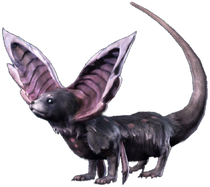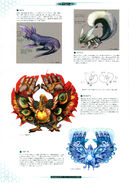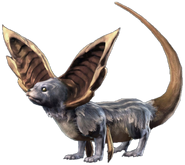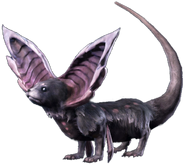No edit summary |
|||
| Line 1: | Line 1: | ||
[[File:Terebra purple.png|thumb|210px|A Terebra]] |
[[File:Terebra purple.png|thumb|210px|A Terebra]] |
||
| − | '''Terebras''' (Japanese: {{lang|ja|ルトル}}, ''Rutoru'') are otter-like creatures in ''[[Xenoblade Chronicles X]]''. They have long bodies with four short legs and a thick tapered tail, giving them a streamlined shape well-suited for swimming. Unlike otters, they have extremely large forward-facing ears. They are much larger than real otters, though still small compared to most [[Mira]]n indigens. They can be found in [[Primordia]] and [[Noctilum]]. |
+ | '''Terebras''' (Japanese: {{lang|ja|ルトル}}, ''Rutoru'') are otter-like creatures in ''[[Xenoblade Chronicles X]]''. They have long bodies with four short legs and a thick tapered tail, giving them a streamlined shape well-suited for swimming. Unlike otters, they have extremely large forward-facing ears that can be closed over their heads, for defense or added aqua-dynamics. They are much larger than real otters, though still small compared to most [[Mira]]n indigens. They can be found in [[Primordia]] and [[Noctilum]]. |
== Description == |
== Description == |
||
Revision as of 15:39, 26 May 2020

A Terebra
Terebras (Japanese: ルトル, Rutoru) are otter-like creatures in Xenoblade Chronicles X. They have long bodies with four short legs and a thick tapered tail, giving them a streamlined shape well-suited for swimming. Unlike otters, they have extremely large forward-facing ears that can be closed over their heads, for defense or added aqua-dynamics. They are much larger than real otters, though still small compared to most Miran indigens. They can be found in Primordia and Noctilum.
Description
"Terebras are technically omnivorous, though their main diet consists of aquatic organisms snagged from rivers, such as fish and shellfish. Their ear-shaped bony ruffs can be positioned into a drill-like shape, an ability they use to fight enemies and build dwellings."
"Once excavated, a terebra den will extend deep underground and house the entire pack of a dozen or so terebras. The entrance is constantly guarded by several pack members that stand erect on their hind legs."
"Terebra fur has commercial value due to its excellent heat insulation and softness--so long as the barbed bristles are removed."
Color Variants
Terebras fall into two color variants:
- Light terebras have light grey fur, white stripes, and golden ears and tail. They can drop Terebra Oil Grease.
- Dark terebras have purple-grey fur, red spots, reddish purple ears, and grey tail. They can drop Terebra Water Grease.
List of Terebras
| Name | Variant | Type | Location | Time | Weather | Level |
|---|---|---|---|---|---|---|
| Lake Terebra | Dark | Normal | Primordia | Anytime | All | 1 – 10 |
| Whirling Terebra | Dark | Normal | Primordia | Anytime | All | 21 – 30 |
| Pit Terebra | Dark | Normal | Primordia | Anytime | All | 11 – 20 |
| Fell Terebra | Light | Normal | Primordia | Anytime | All | 51 – 60 |
| Pond Terebra | Light | Normal | Noctilum | Anytime | All | 11 – 20 |
| Crusher Terebra | Light | Normal | Noctilum | Anytime | All | 31 – 40 |
| Shinhwa, the Sagacious | Dark | Tyrant | Noctilum | Anytime | All | 24 |
| Archibolt, the Revolutionary | Light | Tyrant | Primordia | Anytime | Rain | 11 |
| Stagnant Terebra | Dark | Normal | Primordia | Water Woes | All | 21 – 23 |
| Nomad Terebra | Light | Normal | Noctilum | Anytime | All | 21 – 30 |
| Lowly Terebra | Dark | Normal | Primordia | Setting Forth | All | 32 |
| Parched Terebra | Dark | Normal | Noctilum | No-show Nen'celeg | All | 30-31 |
Etymology
Terebra means "borer," referring to their drill-like ears.
The Japanese name Lutor is derived from the Latin word "Lotor", meaning "washer".



